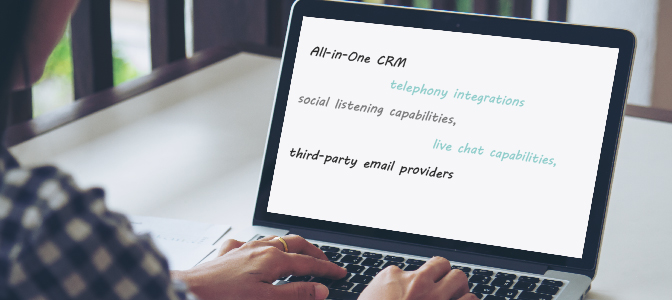7 clever ways to boost customer satisfaction with help desk software
Customer satisfaction is an often overlooked, but highly essential element of business growth. It’s simple: satisfied customers stick around longer and display brand loyalty. Unsatisfied customers leave you for a competitor. Many tactics will increase your customer satisfaction rates. But, did you know that some of the cleverest tactics involve the use of help desk software?
This is not rocket science in any way; it’s quite simple. Let’s dig in and discuss seven tips for boosting customer satisfaction with help desk software.
1. Leverage help desk software with multichannel support

When customers have issues, they may try to contact you through various communication channels. If you use an all-in-one CRM, you can monitor every channel and be there when your customers need you.
An all-in-one CRM that provides telephony integrations allows you to streamline the routing and resolution of incoming customer support calls.
If your system provides social listening capabilities, you can be notified instantly when a customer reaches out via social media and respond in a flash.
Assuming your help desk software provides live chat capabilities, your reps can assist customers in real time via live chat pop-ups on your website.
And when you can integrate your help desk software with various third-party email providers, you can ensure help desk tickets submitted via email are instantly routed and followed up with as soon as possible.
The goal is to allow customers to request support using the communication channel they prefer. An all-in-one CRM lets you do that and minimizes resolution times, which keeps customers satisfied.
Related Blog: Will chatbots replace live support agents?
2. Use help desk groups to deliver expert support every time

What are help desk groups? Here’s an example to illustrate how they work:
- You create groups of customer support reps that specialize in a given product or service…
- With the help of system tags, you label those reps as being experts in Product X or Y…
- Customer A emails support to submit a help desk ticket…
- Your help desk system automatically knows that Customer A owns Product X…
- When Customer A submits her ticket, the system automatically routes it to someone in the help desk group dedicated to supporting Product X…
- Customer A gets expert customer support every time because she always gets routed to a support rep who is an expert in the product she uses…
- Customer A is always satisfied with her customer support experience because her issue is always handled by a rep who is equipped to solve her issue quickly and effectively.
That’s just a simple example. You can create help desk groups around any attribute, such as geographical location or language spoken. The bottom line is that helpdesk groups allow you to automate the routing of incoming help desk tickets to the support reps who are best equipped to solve the issue as quickly as possible.
3. Increase first contact resolution rate (FCR)

First contact resolution rate (FCR) refers to the percentage of incoming help desk tickets that are resolved on the first attempt. There is no ongoing back and forth.
By providing multichannel support and leveraging help desk groups, you can dramatically increase your FCR. This is important for two key reasons:
- It displays respect for your customers’ time. When you resolve an issue on the first attempt, it allows your customers to get back to work and eliminates time-consuming back and forth. Studies show that 77% of consumers say that valuing their time is the most important thing a company can do to provide them with good service.
- A high FCR is directly tied to higher levels of customer satisfaction. Research reveals a direct link between a higher FCR and elevated customer satisfaction levels (see the chart below).
Source: HDI
4. Set clear expectations with service level agreements

Service level agreements (SLAs) outline the type and level of support a customer can expect when they submit a help desk ticket. SLAs specify the amount of time a customer should expect to wait for a response to a submitted ticket, how long they should expect to wait for a resolution, and so on.
SLAs don’t just set expectations for the customer, but also for your support team. They provide clear guidelines that reps must follow, which motivates reps to meet those expectations. They also let you hold reps accountable for not delivering on their end of the bargain.
Pro tip: Don’t just try to meet the expectations laid out in your SLAs. Aim to exceed those expectations every time. If your customers expect to wait four hours for a response, but you respond in 15 minutes, you can be sure that customer satisfaction will rise.
5. Personalize your customer support
When people need support, they want to be treated like a human, not a case number. A great benefit of an all-in-one CRM is that it stores immense amounts of personal contact data for each customer. That includes every marketing touchpoint, all the products they own, past support tickets they submitted, and even personal information like their interests, geographical location, etc.
When your support reps have access to this information—i.e., it pops up on the screen in front of them as they take a support case—they can treat your customer like a human. They can personalize their support by using that information to establish a rapport with the customer.
Simply put, when someone feels personally catered to, they come away feeling much better about the experience. Personalized customer support helps you deliver an overall better customer experience, which is critically important to your bottom line.
Studies show that 80% of consumers are willing to pay more for a better customer experience. And personalizing your help desk support makes delivering an improved customer experience a breeze. It’s one of many ways help desk software benefits your customer service efforts.
6. Make it easy for customers to leave feedback
Don’t just make it easy to leave feedback. Take your customers’ feedback and make proactive changes to reflect their needs.
How can you facilitate the collection of customer feedback?
You can use automation in your all-in-one CRM to automatically send an online survey via email once a help desk ticket is resolved.
If you have a help desk knowledge base (KB), you can enable knowledge base content feedback. This lets customers comment on existing KB articles and request new ones to fill potential gaps in your KB archives.
Pro tip: When you make upgrades to your product or service based on customer feedback, be sure to let your customers know about it via an email newsletter, or by calling them directly. When customers see that you are implementing changes based on their specific needs, customer satisfaction will rise, along with brand loyalty and your reputation in the market.
7. Measure, analyze, and improve

The famous Peter Drucker—a.k.a. “the founder of modern management”—once said: “If you can’t measure it, you can’t improve it.” How right he was!
Increasing customer satisfaction using help desk software is a fairly difficult task if you are not able to measure your performance. Performance measurement allows you to identify areas of strength and weakness so that you can address areas in need of improvement.
To maintain high levels of customer satisfaction, you need to deliver high-quality customer support. But to truly delight your customers, you must be able to deliver high-quality service today, and even better service tomorrow.
Continuous improvement is made easy if you have access to help desk reporting and analytics. You can track metrics such as:
- First contact resolution rate
- Average response times
- Ticket backlog
- Adherence to SLAs
- Customer support survey results
- Knowledgebase article rankings
- And much more
When you have that level of insight at your fingertips, you can hone in on what needs to be improved to maintain world-class customer satisfaction levels. You can use that insight to make data-driven decisions, form strategy, and develop plans to continuously improve your help desk team’s efforts.
Conclusion
Maintaining satisfied customers is key to sustainably growing your business. You’ve probably heard that it costs five times more to acquire a new customer than to retain an existing one.
Most of your future revenue will come from your existing customers, particularly if your product is subscription-based.
It’s imperative to focus on keeping existing customers happy. And following the clever tips above, you can leverage your help desk software to keep satisfaction levels high.
You need to find the best help desk software to meet your needs. Whether you’re looking for help desk software for a small business or an enterprise level company, an all-in-one CRM could be the solution you’re looking for.
Regardless of which solution you use to manage your help desk ticketing process, the key to generating satisfied customers lies in:
- Closing tickets as quickly as possible
- Making customers feel valued
- Truly listening to their concerns
- Measuring your performance to constantly improve your results
Derek Sivers, Founder of CD Baby, summed it up nicely when he said: “The single most important thing is to make people happy. If you are making people happy, as a side effect, they will be happy to open up their wallets and pay you.”
Focus on delighting your customers, and the rest will take care of itself.



1 Comment
Wolken
about 6 years agoIt is now acknowledged that a service desk software helps you handle the ever-increasing customer requests and demands but it is not a ‘set up-forget it’ element of the company. It represents one of the public interfaces of the company and to maintain its good health requires periodic assessment and review is needed.
Reply